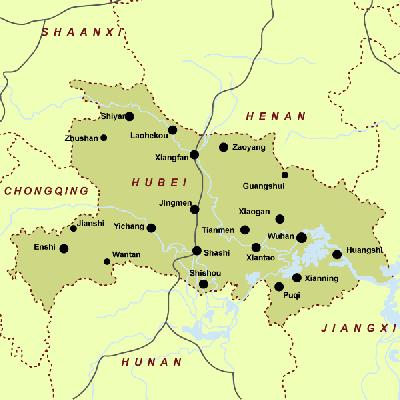| Map |
|
|
Hubei
Hubei has a sub-tropical monsoonal climate, with a mean annual temperature of 15oC-17oC -- the hottest month, July, averaging 27-30oC and the coldest month, January, 1-5oC -- and a mean annual precipitation of 800-1600 mm.
It is divided into 1 autonomous prefecture, 12 prefecture-level cities, 24 county-level cities, 39 counties, 2 autonomous counties and one forest district, with a population of 60.28 million as of 2000, mainly including ethnic groups of Han, Tu, Miao, Hui, Dong, Manchu, Zhuang, and Mongolian.
An important feature of Hubei food is its blending of fish with other ingredients, including Steamed Blunt-Snout Bream, Dried Sheets of Bean Curd, and Boiled Dumpling, etc.
Han Opera, Chu Opera, Huangmeixi (opera-style), acrobatics, and the art of singing and storytelling such as Pingshu, Dagu, etc.
Hubei Province is called E for short, with Wuhan as its provincial capital. It is rich in agriculture, forestry and hydropower resources. Agriculture and fishery are well developed in Hubei, with such main products like paddy rice, wheat, ramie, cotton, silk, tea, orange, fish, and vegetable oil, the outputs of which are among the top of the country. Its main industries include iron and steel, machinery, power and automobile.
Renowned as the Province of a Thousand Lakes, Hubei abounds in natural, historic and cultural resources. The main places of historic interest and scenic beauty include the Three Gorges of the Yangtze River, the East Lake and the Yellow Crane Tower in Wuhan, ancient Longzhong (a strategic place of importance in ancient time) in Wuhan City, the Temple of Emperor Yan in Suizhou, the Hometown of Quyuan in Zigui, Wudang Mountain (famous for martial arts), Jiugong Mountain and Shennongjia (a place of primitive forest), etc. |
||||
 |
 Geography
Geography